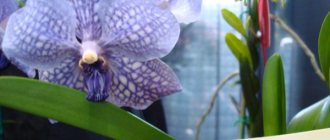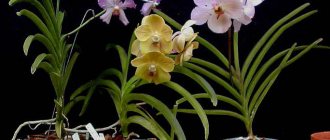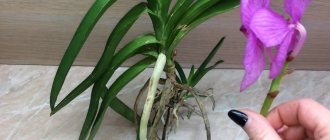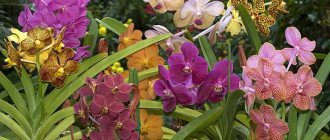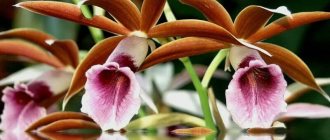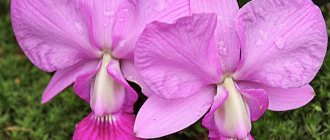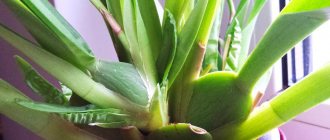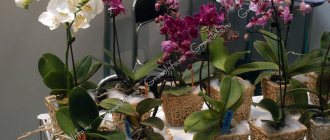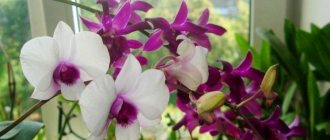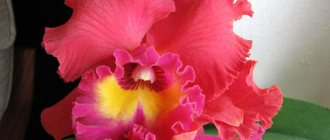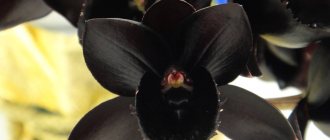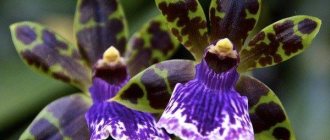This variety of orchid goes back to the 18th century in Asian countries. That's where she comes from.
In addition to its beautiful flowers, this orchid is unique for its root system : unlike other varieties, its roots are more powerful, they can receive moisture even from the atmosphere. Therefore, the Vanda orchid is not threatened by prolonged droughts and possible burns. However, this variety is quite whimsical and will require great care during care . One slight mistake and the plant may die. Next we will tell you how to care for the beautiful Wanda.
Conditions of detention
Since this variety comes from hot latitudes, the maintenance conditions must be appropriate:
- the air temperature should be between 16-29 degrees; if the room is more than 30 degrees, the plant may die;
- humidity should be within 80% (this figure can be maintained by regularly spraying the plant);
- Vanda does not require any substrate ; its root system must be constantly open. As a last resort, you can use oak bark as in the case of Phalaenopsis;
- This plant is very light-loving , but it is worth limiting direct sunlight. It is especially important to maintain proper lighting in winter; in summer, the orchid can be placed on the balcony;
- When planting in the ground, water the plant, just like other varieties of orchids: as the substrate dries.
Vanda's root system can be left open.
Important! The temperature to maintain this flower should be the same throughout the year.
Vanda does not have periods of rest or active growth . Only during flowering can the growth of its leaves stop. Strong changes in temperature can provoke a lot of diseases for the flower. It is best to keep Vanda open (without adding soil).
Features of Vanda
Vanda was first mentioned in his diary by a certain William Jones, who studied Asia. The entry is dated 1795. The name Vanda was given to the plant by local residents. The name of this amazing and majestic orchid sounds like the rustling of the wings of a cute little bird, like the name of a lovely girl, like the wind in the vast ferns of a forest untouched by civilization.
This epiphyte is a representative of the Orchidaceae family. Under natural conditions, it is found in tropical latitudes in Indonesia, India, the Philippines, Southern China and Northern Australia. In total, more than 20 thousand species of vanda have been described. In addition to the fact that this plant is incredibly beautiful, it has another distinctive feature - its powerful greenish-gray root system is covered with velamen. This is a layer of dead cells that has a decent thickness. Since velamen has a porous structure, it is able to absorb moisture even from the air. Thanks to this, the root system has reliable protection from sunburn and dehydration.
The height of the stem of indoor vanda often exceeds 100 cm, and therefore it is often cultivated as a cut plant. The alternately arranged belt-shaped leaf plates are leathery to the touch and have a pale gray or green color. Erect or drooping peduncles grow from the leaf axils, each of which produces 2–15 flowers. In this case, from 1 to 4 peduncles can grow on a bush.
The racemose inflorescences consist of fragrant large flowers, which can have a wide variety of colors, for example: yellow, red, orange, white, blue, etc. A distinctive feature of the vanda is also that its opened flowers become larger day by day, and their color is more saturated. The bush blooms for about 6 weeks. However, if you provide it with proper care, it will bloom several times throughout the year.
Planting and transplanting
Planting and caring for Vanda has its own characteristics:
- No soil is required for planting it. Very often, orchid lovers simply hang the plant on the wall and leave its root system open;
- for less experienced gardeners, it is allowed to use a small amount of substrate in the form of oak bark;
- You can also use a plastic container with a lot of holes in it. The entire root system of the orchid is placed in it, and thanks to the holes, a sufficient amount of moisture, light and air enters it.
This variety of orchid does not need to be replanted. Wanda doesn’t like changing the pot, so having bought an orchid in a small plastic pot at the store, it’s better not to disturb it for a while with replantings. Today, many orchid lovers prefer to grow Vanda in large glass pots. We'll talk about this a little later.
Advice! When using a substrate, it must be changed at least once every 6 months.
What pests are dangerous for orchids?
The crop is not often attacked by pests, but if the rules of care are not followed, spider mites, mealybugs, and scale insects may appear. Remove them with a cotton swab soaked in an alcohol or soap solution. The procedure must be repeated, treating both leaves and stems.
In case of severe damage, you will have to resort to insecticide treatment.
It is quite possible to grow the Vanda orchid at home, having familiarized yourself in advance with the peculiarities of growing and caring for the crop, and then the unusual, beautiful and long-flowering plant will delight you for many years.
Vanda Orchid: home care
Since this variety of orchids is mainly grown without the use of a substrate, watering must be done as follows: the entire root system is carefully placed in a container of water and kept there for about 20-30 minutes. After that, take it out and let it drain a little. It is very important not to wet the stems and leaves when watering.
You need to water the plant:
- in summer, once every 4 days;
- in winter no more than once a week.
If a substrate is used when growing Vanda, then the frequency of watering should be reduced to once a week in the summer and once every 14 days in the winter. More frequent watering leads to rotting of the root system and death of the plant.
For watering, the roots of the plant are completely immersed in water.
Important! To increase the humidity level, it is allowed to spray the orchid once every 7 days in winter and 2 times a week in summer. In this case, you need to make sure that water does not get on the stems, leaves and flowers.
When using a glass container, watering is carried out as follows: carefully pour clean water into the vase in a small stream so that the roots are immersed in it. Let it sit for about half an hour, then drain it thoroughly.
This procedure is carried out twice a week in summer and once in winter . When using glass vases, watering must be done very carefully to prevent rotting of the root system (this can occur due to limited air access).
Complementary feeding is carried out during the period of Vanda's vegetative growth . Use special fertilizers with the addition of potassium monophosphate. Take based on the proportion of 1 g of fertilizer per 1000 ml of water. Fertilize, as a rule, once a month. It is important to note that complementary feeding is best introduced after Vanda has finished flowering.
As mentioned above, this variety of orchids does not have a clearly defined period of growth and dormancy. Abundance of flowering is observed in spring and summer (this is caused by greater natural light).
The flowering period can last up to 2-3 months . If properly maintained, the Vanda orchid will delight its owner with flowering all year long.
The flowers of the plant are simply unique, they have different shapes and colors. If flowering does not occur for a long time, then you need to check whether the plant has enough color, whether there are temperature changes, or perhaps it is simply overfed with fertilizers.
After flowering has ended, it is necessary to trim dried flower stalks and reduce watering and spraying to a minimum.
Reproduction
Like all other types of orchids, Vanda reproduces by transplanting its children . This phenomenon is quite rare; they can be separated from the main root system when the child’s roots reach a length of at least 5 cm . After circumcision of the baby, the place of attachment to the roots must be treated with charcoal to prevent the spread of infection.
Orchid Vanda (photo with baby).
The baby is placed in a special pot and kept in greenhouse conditions, while the air humidity should be about 90%. Tree bark and sphagnum moss (4:1) are used as a substrate. In this way, the baby is kept until it grows 20 cm in length, then it can be transplanted into a regular orchid pot and continued care as for an adult plant.
It should be noted that any other methods of transplanting this plant are prohibited . However, diligent flower growers sometimes try to propagate Vanda using seeds. This is a very long and labor-intensive process.
Features of the process, how to grow from a seed:
- seeds are grown in a nutrient medium, which is obtained under sterile laboratory conditions;
- germination duration is about 9 months;
- it takes up to 3 years to get a shoot that can be transplanted;
- Flowering of a plant grown in this way can take up to 4-10 years.
For propagation, therefore, you will need Vanda orchid seeds, moist soil (moss and deciduous soil), conditions of complete sterility, temperature within 25 degrees, humidity - 80-90%. After the first leaves appear, they need to be picked.
Vanda varieties with photos
Below we will describe those varieties of homemade vanda orchid that are most popular among gardeners.
Blue Vanda (Vanda coerulea)
The stems of this epiphytic plant are erect, and their height can reach up to 100 centimeters. The bush has many strong, developed roots. Dense belt-shaped sheet plates are placed in 2 rows. The peduncle, together with the multi-flowered racemose inflorescence, reaches up to 0.5 m in length, with 6–12 flowers formed on one peduncle. Large fragrant flowers reach about 10 centimeters in diameter. The petals are bluish-gray in color and have a striking mesh pattern of a darker shade. The lip of the flower is smaller than the rest of its parts, but it has a brighter color. Over time, the color of the petals becomes lighter.
Vanda tricolor
This is a tall and large plant, the height of the stem is more than 150 cm. The length of the leathery, belt-shaped leaf plates is 25–40 centimeters, they are placed in two rows. The inflorescence consists of 7–10 fragrant flowers, shaped like a star, which reach about 70 mm in diameter. The petals and sepals with a wide nail are oval in shape and have a wavy edge. They can be creamy white or just white, their surface is decorated with many specks of a dark red hue. The petals are the same length as the three-lobed lip. The central blade is the largest and has the shape of a guitar; it has an inky pink color.
Vanda sanderiana
Such a large epiphytic plant is decorated with belt-shaped foliage, the length of which is about 40 centimeters. The apical straight inflorescences include about 10 flowers, reaching about 15 centimeters in diameter. The petals of the flowers are pink with a white edge, and the lip is reddish-yellow.
Vanda Rothschildiana
This variety is the result of crossing Vanda Sander and Blue Vanda. The bush has belt-shaped leaf plates. The multi-flowered inflorescences include bluish flowers, reaching 40–50 mm in diameter.
Vanda teres
The bush's stem is highly branched, and its height is about 250 cm. The stem can be either climbing or drooping; it has a large number of aerial roots. The peduncle includes 3–6 flowers, the diameter of which reaches 10 centimeters; they can be pale red or light pink. The shape of the sepals and petals is oval (almost round) or diamond-shaped, their edges are wavy. The lip has 3 lobes; the lateral lobes are yellow at the base and decorated with many speckles of a red hue, and the central one is broadly wedge-shaped, bifid, purple in color.
The vanda orchid is grown for cutting, it is used to create an unusual, mysterious atmosphere of a tropical forest, and it is used to decorate apartments. Every year, breeders create new varieties of vanda that adapt better to indoor conditions. Despite its capricious nature, this plant is still very popular among orchid lovers.
VANDA: basics of care - lecture for beginners
Growing
In a glass vase
Very often I use glass containers to breed these orchids, but growing in a glass flask has its own nuances.
How to plant correctly?
To plant Vanda in such a container, you need to choose a pot that has a cone shape . The roots of the plant are carefully placed in it so that the leaves are on top of the sides .
A healthy orchid has bright green leaves and stems and blooms profusely. The roots are not dried and have a natural color.
Correct position in the vase.
When growing in glass, the use of any substrate is not required . Watering should be carried out no more than once a week in winter and 2 times a week in summer. More frequent moistening can lead to rotting of the root system and death of the orchid.
It is necessary to monitor the lighting , as glass prevents the penetration of sunlight.
Possible problems
Vanda is a very whimsical plant, so its owner needs to have a lot of patience and then the flower will definitely thank you. If your orchid leaves turn yellow, you need to check:
- temperature in the room;
- is there an unpleasant neighborhood?
- humidity and lighting levels;
- overfeeding with fertilizers.
Sometimes the plant is prone to naturally dropping leaves. Root rot can be caused by excess moisture, so it is worth reducing the amount of watering.
The dropping of flowers and buds can occur due to overheating of the orchid. In this case, it is imperative to monitor the temperature in the room where Wanda is kept.
Reanimation of a plant with no roots
This can be accomplished by growing new roots from the neck of the plant. Technology on how to revive such a Wanda:
- you need to take ordinary boiled water and a section of the orchid;
- it is placed in a vessel so that the leaves remain on top;
- they are placed in a kind of greenhouse, where the temperature is maintained at 25 degrees around the clock;
- As the liquid evaporates, it must be added.
After just a few months, you can see fresh roots and replant the orchid.
The orchid is reanimated by placing it in water.
Diseases, their treatment and prevention
Important! Like other types of orchids, Vanda is susceptible to many diseases: burns, fungal infections, bacterial rot.
For prevention, you need to carefully monitor temperature and humidity , and treat the plant with fungicidal preparations. If rot is detected, you need to treat the orchid with an antibiotic solution.
To prevent the proliferation of pests, you can treat Vanda with an alcohol-soap solution.
Diseases and pests
Vandas are mainly affected by infectious fungal diseases. The most common of them is Fusarium. In addition, there is the possibility of infection:
- Phyllostictosis or black spotting;
- Bacteriosis or wet bacterial rot;
- Bacterial spotting;
- Fungal infection caused by fungi of the genus Capnodium or Meliola;
- Southern sclerotial rot or “dry” rot;
- Bacterial disease caused by Pseudomonas cattleyae.
Insects and pests are not very fond of these orchids due to their dense, hard leaves. However, if there is overfeeding, disease or a large number of pests, insect damage still occurs. Their favorite place to live on the plant is young leaves - that is, the growth point. Therefore, the orchid needs to be treated with insecticides at least once a year.
Oksana Igorevna Kadesnikova I have been collecting orchids for more than 10 years. The collection includes more than 100 pieces: cattleyas, vandaceae, cymbidiums, coelogines, oncidium group, phalaenopsis. I have practically no other flowers, except perhaps at the dacha.
